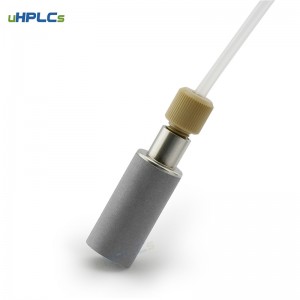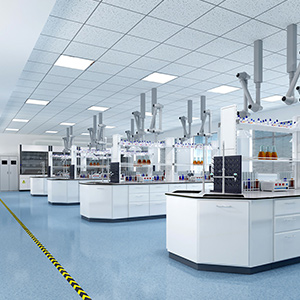Ever had a meltdown over the constant bubbles when operating high-performance liquid chromatography? Have you ever fainted because the mobile phase still appears bubbles after an hour of ultrasonic shaking? Have you ever lost confidence in your work because no bubbles appear when the weather is fine, and
on a cloudy or rainy day, bubbles appear in the same bottle?
When operating high-performance liquid chromatography, bubbles appear in the mobile phase; the whole work can not be carried out.
The reason why air bubbles do not appear when the weather is fine but appear on cloudy or rainy days is that the air pressure drops on cloudy or rainy days, causing the air dissolved in the mobile phase to be oversaturated (not yet saturated when the air pressure is high on sunny days), and when the high-pressure pump extracts the mobile phase, the air precipitates and bubbles are produced.

Ultrasonic shock for an hour of the mobile phase, why is there still air inside? It is due to the shock at atmospheric pressure; the effect of driving out the air is not effective.
What will be the effect if the bottle containing the mobile phase is evacuated and ultrasonic shock is performed simultaneously? The effect is very good. As long as 1 min, the air in the mobile phase is almost gone; after such expulsion of air in the mobile phase, the air bubbles will not appear even on cloudy or rainy days; and save time, do not have to move half an hour, an hour ultrasonic shock; and the effect is very good.
The presence of air bubbles will cause sharp noise peaks on the chromatogram, which will seriously cause a decrease in analytical sensitivity; air bubbles becoming large into the flow path or column will make the mobile phase flow rate slow or unstable so that the baseline fluctuations.
There are three main reasons for the above phenomenon.
First, the mobile phase solution is often due to dissolved oxygen or mixed with air and the formation of bubbles.
Second, the system fails to drive out the air in the flow path when it starts working.
The third is the accidental mixing of air when injecting samples.
And the liquid chromatograph in use, the entire liquid path system has two places easy to produce bubbles!
1, pump head suction white tube; 2, detection port flow cell.
Most of the reasons for the generation of air bubbles are due.
Temperature rise, pressure drop! Temperature rise or column temperature rise, when close to the boiling point of reagents, vaporize to produce bubbles; reagents already contain tiny bubbles, due to heating, to become larger and produce bubbles.
Pressure drop produces bubbles; the mobile phase has always contained tiny bubbles, regardless of ultrasonic filtration, can not pool the bottom to remove it, then when the pressure drops, tiny bubbles will grow, and multiple small bubbles are easy to gather into large bubbles, and affect the normal experiment.

The causes of air bubbles and solutions:
First, the pump head and white suction tube.
1, the pump head: the pump head is the most dramatic pressure change but also the most likely to produce bubbles, the pump head by the negative pressure and suction, and the negative pressure is bound to make the mobile phase of the small bubbles grow when the pump cavity becomes positive pressure, has grown bubbles may not all become smaller into the subsequent liquid path, the pump cavity will accumulate bubbles, thus affecting the accuracy of suction, given this, the pump head specially designed exhaust valve, to facilitate the pump head exhaust, observe The column pressure is stable, indicating that the pump head exhaust success.
2, the suction white tube long bubbles.
a, white suction tube is in contact with the aerial parts of the leakage, resulting in visible bubbles; A white suction tube is an atmospheric pressure and negative pressure cross-arm change parts, its leakage performance for the atmosphere into the white tube, and not easy to see the liquid leakage in the tube.
Treatment: Replace the white tube.
b, inlet filter plugging: inlet filter plugging makes the liquid flow into the solvent inlet filter speed drop, the pump forced suction and vacuum bubbles.
Judgment: pull out the inlet filter. No longer long bubble is filtered head plugging.
Treatment: A, 30% nitric acid aqueous solution superwash filter head, about 20 minutes. b, water superwash filter head, pay attention to change the water more super several times.

c, mobile phase vaporization bubbles.
Especially in summer, high room temperature and low boiling point of reagents are easy to vaporize, such as acetic acid, ether, ammonia, petroleum ether, etc…
Treatment: ultrasound, reduce the room temperature.
The second is the detection of long bubbles in the flow cell.
Circulation pool is easy to accumulate bubbles, its huge impact on the baseline, the mobile phase into the column, the pressure is getting smaller and smaller, tiny bubbles will gradually grow, and circulation pool cross-sectional area is much larger than the area of the steel pipe, the bubble in the pool is easy to grow, the bubble is characterized by growth in the absence of external pressure, it is difficult to shrink to the steel pipe by the following flow out of the circulation pool, so it exists in the pool. Treatment:
1, For the differential detector pool, can only withstand a few kilograms of pressure, can only be repeatedly flushed repulsive, lift the waste bottle by the liquid column in the waste tube to the pool plus a tiny counterpressure, so this relies on the differential pool exhaust difficulties, but there is no other way.
To avoid such problems, the actual analysis process of liquid chromatography must pay attention to the degassing of the mobile phase.

Commonly used degassing methods are as follows:
1. blowing helium degassing method Using helium gas, which is less soluble than air in liquids, the mobile phase is passed at a flow rate of about 60 ml/min for 10-15 min under 0.1 MPa pressure to drive out the dissolved gas. This method is used for all solvents and has a good degassing effect, but it is less used in China because of the high price of helium.
2. heated reflux method The degassing effect of this method is better.
3. evacuation degassing method, In this case, a miniature vacuum pump can be used to reduce the pressure to 0.05-0.07MPa to remove the dissolved gas in the area. Using the pump connected to the pumping bottle and G4 microporous glass funnel can together complete the dual task of filtering mechanical impurities and degassing. Since the vacuum will cause changes in the composition of mixed solvents, this method is suitable for single solvent system degassing. The multi-solvent system should be pre-degassed and mixed to ensure the same ratio.
4. ultrasonic degassing method: Currently the most widely used method in the laboratory, the prepared flow connected with the container into the ultrasonic water tank degassing 10-20min can be. This method is easy to operate and can meet the requirements of daily analysis.
5. Online vacuum degassing method The vacuum degassing device is connected to the storage system in series and combined with a membrane filter to achieve the continuous vacuum degassing of the mobile phase before entering the infusion pump. The degassing effect of this method is better than the above and applies to multi-solvent systems.
Their treatment of air bubbles in liquid chromatography was shared with you today; uHPLCs hope it will help!
Post time: Sep-03-2022






